Abstract
Doped semiconductors are the most important building elements for modern electronic devices1. In silicon-based integrated circuits, facile and controllable fabrication and integration of these materials can be realized without introducing a high-resistance interface2,3. Besides, the emergence of two-dimensional (2D) materials enables the realization of atomically thin integrated circuits4,5,6,7,8,9. However, the 2D nature of these materials precludes the use of traditional ion implantation techniques for carrier doping and further hinders device development10. Here, we demonstrate a solvent-based intercalation method to achieve p-type, n-type and degenerately doped semiconductors in the same parent material at the atomically thin limit. In contrast to naturally grown n-type S-vacancy SnS2, Cu intercalated bilayer SnS2 obtained by this technique displays a hole field-effect mobility of ~40 cm2 V−1 s−1, and the obtained Co-SnS2 exhibits a metal-like behaviour with sheet resistance comparable to that of few-layer graphene5. Combining this intercalation technique with lithography, an atomically seamless p–n–metal junction could be further realized with precise size and spatial control, which makes in-plane heterostructures practically applicable for integrated devices and other 2D materials. Therefore, the presented intercalation method can open a new avenue connecting the previously disparate worlds of integrated circuits and atomically thin materials.
This is a preview of subscription content, access via your institution
Access options
Access Nature and 54 other Nature Portfolio journals
Get Nature+, our best-value online-access subscription
$29.99 / 30 days
cancel any time
Subscribe to this journal
Receive 12 print issues and online access
$259.00 per year
only $21.58 per issue
Buy this article
- Purchase on Springer Link
- Instant access to full article PDF
Prices may be subject to local taxes which are calculated during checkout




Similar content being viewed by others
References
Tan, C. et al. Recent advances in ultrathin two-dimensional nanomaterials. Chem. Rev. 117, 6225–6331 (2017).
Kappera, R. et al. Phase-engineered low-resistance contacts for ultrathin MoS2 transistors. Nat. Mater. 13, 1128–1134 (2014).
Li, M. Y. et al. Epitaxial growth of a monolayer WSe2–MoS2 lateral p–n junction with an atomically sharp interface. Science 349, 524–528 (2015).
Sarkar, D. et al. A subthermionic tunnel field-effect transistor with an atomically thin channel. Nature 526, 91–95 (2015).
Novoselov, K. S. et al. Two-dimensional gas of massless Dirac fermions in graphene. Nature 438, 197–200 (2005).
Pospischil, A., Furchi, M. M. & Mueller, T. Solar-energy conversion and light emission in an atomic monolayer p–n diode. Nat. Nanotech. 9, 257–261 (2014).
Radisavljevic, B., Radenovic, A., Brivio, J., Giacometti, V. & Kis, A. Single-layer MoS2 transistors. Nat. Nanotech. 6, 147–150 (2011).
Huang, C. M. et al. Lateral heterojunctions within monolayer MoSe2–WSe2 semiconductors. Nat. Mater. 13, 1096–1101 (2014).
Gong, Y. J. et al. Vertical and in-plane heterostructures from WS2/MoS2 monolayers. Nat. Mater. 13, 1135–1142 (2014).
Lei, S. D. et al. Surface functionalization of two-dimensional metal chalcogenides by Lewis acid–base chemistry. Nat. Nanotech. 11, 465–471 (2016).
Mak, K. F., Lee, C., Hone, J., Shan, J. & Heinz, T. F. Atomically thin MoS2: a new direct-gap semiconductor. Phys. Rev. Lett. 105, 136805 (2010).
Baugher, B. W. H., Churchill, H. O. H., Yang, Y. F. & Jarillo-Herrero, P. Optoelectronic devices based on electrically tunable p–n diodes in a monolayer dichalcogenide. Nat. Nanotech. 9, 262–267 (2014).
Ross, J. S. et al. Electrically tunable excitonic light-emitting diodes based on monolayer WSe2 p–n junctions. Nat. Nanotech. 9, 268–272 (2014).
Li, H. et al. Composition-modulated two-dimensional semiconductor lateral heterostructures via layer-selected atomic substitution. ACS Nano. 11, 961–967 (2017).
Yang, T. et al. Van der Waals epitaxial growth and optoelectronics of large-scale WSe2/SnS2 vertical bilayer p–n junctions. Nat. Commun. 8, 1906 (2017).
Duan, X. D. et al. Lateral epitaxial growth of two-dimensional layered semiconductor heterojunctions. Nat. Nanotech. 9, 1024–1030 (2014).
Allain, A., Kang, J. H., Banerjee, K. & Kis, A. Electrical contacts to two-dimensional semiconductors. Nat. Mater. 14, 1195–1205 (2015).
Wang, L. et al. One-dimensional electrical contact to a two-dimensional material. Science 342, 614–617 (2013).
Cho, S. et al. Phase patterning for ohmic homojunction contact in MoTe2. Science 349, 625–628 (2015).
Koski, K. J. et al. Chemical intercalation of zerovalent metals into 2D layered Bi2Se3 nanoribbons. J. Am. Chem. Soc. 134, 13773–13779 (2012).
Lévy, F. A. (ed.) Intercalated layered materials (Springer, Dordrecht, 1979).
Yuan, H. T. et al. Liquid-gated electric-double-layer transistor on layered metal dichalcogenide, SnS2. Appl. Phys. Lett. 98, 012102 (2011).
Song, H. S. et al. High-performance top-gated monolayer SnS2 field-effect transistors and their integrated logic circuits. Nanoscale 5, 9666–9670 (2013).
Ahn, J. H. et al. Deterministic two-dimensional polymorphism growth of hexagonal n-type SnS2 and orthorhombic p-type SnS Crystals. Nano Lett. 15, 3703–3708 (2015).
Ye, G. et al. Synthesis of large-scale atomic-layer SnS2 through chemical vapor deposition. Nano Res. 10, 2386–2394 (2017).
Yao, J. et al. Optical transmission enhacement through chemically tuned two-dimensional bismuth chalcogenide nanoplates. Nat. Commun. 5, 5670 (2014).
Wang, Y. X. et al. Transforming layered to nonlayered two-dimensional materials: cation exchange of SnS2 to Cu2SnS3. ACS Energy Lett. 1, 175–181 (2016).
Jaegerrnann, W., Ohuchi, F. S. & Parkinson, B. A. Electrochemical and solid state reactions of copper with n-SnS2. Phys. Chem. 93, 29–37 (1989).
Bointon, T. H. et al. Approaching magnetic ordering in graphene materials by FeCl3 intercalation. Nano Lett. 14, 1751–1755 (2014).
Allen, L. J., D’Alfonso, A. J. & Findlay, S. D. Modelling the inelastic scattering of fast electrons. Ultramicroscopy 151, 11–22 (2015).
Xu, B., Fell, C. R., Chi, M. & Meng, Y. S. Identifying surface structural changes in layered Li-excess nickel manganese oxides in high voltage lithium ion batteries: a joint experimental and theoretical study. Energ. Environ. Sci. 4, 2223–2233 (2011).
Chuang, H. J. et al. High mobility WSe2 p- and n-type field-effect transistors contacted by highly doped graphene for low-resistance contacts. Nano Lett. 14, 3594–3601 (2014).
Scholz, G., Joensen, P., Reyes, J. M. & Frindt, R. F. Intercalation of Ag in TaS2 and TiS2. Phys. B & C 105, 214–217 (1981).
Acknowledgements
This work was supported by the Department of Energy (DOE), Office of Basic Energy Sciences, Division of Materials Sciences and Engineering (contract no. DE-AC02-76SF00515). P.T. and S.C.Z. also acknowledge FAME, one of six centres of STARnet, a Semiconductor Research Corporation programme sponsored by MARCO and DARPA. Electron microscopy at ORNL (S.Z.Y., M.F.C. and W.Z.) was supported by the US Department of Energy, Office of Science, Basic Energy Sciences, Materials Sciences and Engineering Division, and was performed in part as a user project at the ORNL Center for Nanophase Materials Sciences, which is a DOE Office of the Science User Facility.
Author information
Authors and Affiliations
Contributions
Y.G. and Y.C. conceived and designed the experiments. Y.G. synthesized the sample and performed the intercalation reaction. H.Y., C.L.W., Y.G. and A.Y. performed sample fabrication and transport measurements. P.T. and S.C.Z. carried out DFT calculations. S.Z.Y., M.F.C. and W.Z. worked on the TEM measurements and analysed the data. A.Y., J.G. and M.L.B. measured the optical reflection spectra of the samples. G.L. performed XPS. All authors participated in discussions and co-wrote the paper.
Corresponding author
Ethics declarations
Competing interests
The authors declare no competing interests
Additional information
Publisher’s note: Springer Nature remains neutral with regard to jurisdictional claims in published maps and institutional affiliations.
Supplementary information
Supplementary Information
Supplementary Methods, Supplementary Table 1, Supplementary Figures 1–23.
Rights and permissions
About this article
Cite this article
Gong, Y., Yuan, H., Wu, CL. et al. Spatially controlled doping of two-dimensional SnS2 through intercalation for electronics. Nature Nanotech 13, 294–299 (2018). https://doi.org/10.1038/s41565-018-0069-3
Received:
Accepted:
Published:
Issue Date:
DOI: https://doi.org/10.1038/s41565-018-0069-3
This article is cited by
-
Recent advances on liquid intercalation and exfoliation of transition metal dichalcogenides: From fundamentals to applications
Nano Research (2024)
-
Diverse atomic structure configurations of metal-doped transition metal dichalcogenides for enhancing hydrogen evolution
Nano Research (2024)
-
Solar-driven efficient heterogeneous subminute water disinfection nanosystem assembled with fingerprint MoS2
Nature Water (2023)
-
Imperfection-enabled memristive switching in van der Waals materials
Nature Electronics (2023)
-
Reversible doping polarity and ultrahigh carrier density in two-dimensional van der Waals ferroelectric heterostructures
Frontiers of Physics (2023)



